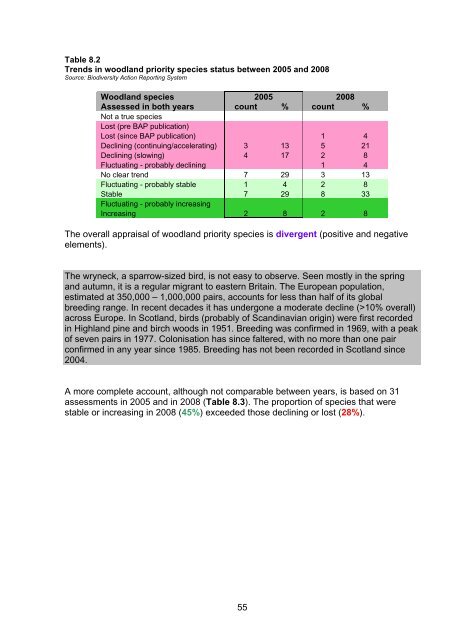Scotland's Wildlife â an assessment of biodiversity in 20
Scotland's Wildlife â an assessment of biodiversity in 20
Scotland's Wildlife â an assessment of biodiversity in 20
You also want an ePaper? Increase the reach of your titles
YUMPU automatically turns print PDFs into web optimized ePapers that Google loves.
Table 8.2<br />
Trends <strong>in</strong> woodl<strong>an</strong>d priority species status between <strong>20</strong>05 <strong>an</strong>d <strong>20</strong>08<br />
Source: Biodiversity Action Report<strong>in</strong>g System<br />
Woodl<strong>an</strong>d species <strong>20</strong>05 <strong>20</strong>08<br />
Assessed <strong>in</strong> both years count % count %<br />
Not a true species<br />
Lost (pre BAP publication)<br />
Lost (s<strong>in</strong>ce BAP publication) 1 4<br />
Decl<strong>in</strong><strong>in</strong>g (cont<strong>in</strong>u<strong>in</strong>g/accelerat<strong>in</strong>g) 3 13 5 21<br />
Decl<strong>in</strong><strong>in</strong>g (slow<strong>in</strong>g) 4 17 2 8<br />
Fluctuat<strong>in</strong>g - probably decl<strong>in</strong><strong>in</strong>g 1 4<br />
No clear trend 7 29 3 13<br />
Fluctuat<strong>in</strong>g - probably stable 1 4 2 8<br />
Stable 7 29 8 33<br />
Fluctuat<strong>in</strong>g - probably <strong>in</strong>creas<strong>in</strong>g<br />
Increas<strong>in</strong>g 2 8 2 8<br />
The overall appraisal <strong>of</strong> woodl<strong>an</strong>d priority species is divergent (positive <strong>an</strong>d negative<br />
elements).<br />
The wryneck, a sparrow-sized bird, is not easy to observe. Seen mostly <strong>in</strong> the spr<strong>in</strong>g<br />
<strong>an</strong>d autumn, it is a regular migr<strong>an</strong>t to eastern Brita<strong>in</strong>. The Europe<strong>an</strong> population,<br />
estimated at 350,000 – 1,000,000 pairs, accounts for less th<strong>an</strong> half <strong>of</strong> its global<br />
breed<strong>in</strong>g r<strong>an</strong>ge. In recent decades it has undergone a moderate decl<strong>in</strong>e (>10% overall)<br />
across Europe. In Scotl<strong>an</strong>d, birds (probably <strong>of</strong> Sc<strong>an</strong>d<strong>in</strong>avi<strong>an</strong> orig<strong>in</strong>) were first recorded<br />
<strong>in</strong> Highl<strong>an</strong>d p<strong>in</strong>e <strong>an</strong>d birch woods <strong>in</strong> 1951. Breed<strong>in</strong>g was confirmed <strong>in</strong> 1969, with a peak<br />
<strong>of</strong> seven pairs <strong>in</strong> 1977. Colonisation has s<strong>in</strong>ce faltered, with no more th<strong>an</strong> one pair<br />
confirmed <strong>in</strong> <strong>an</strong>y year s<strong>in</strong>ce 1985. Breed<strong>in</strong>g has not been recorded <strong>in</strong> Scotl<strong>an</strong>d s<strong>in</strong>ce<br />
<strong>20</strong>04.<br />
A more complete account, although not comparable between years, is based on 31<br />
<strong>assessment</strong>s <strong>in</strong> <strong>20</strong>05 <strong>an</strong>d <strong>in</strong> <strong>20</strong>08 (Table 8.3). The proportion <strong>of</strong> species that were<br />
stable or <strong>in</strong>creas<strong>in</strong>g <strong>in</strong> <strong>20</strong>08 (45%) exceeded those decl<strong>in</strong><strong>in</strong>g or lost (28%).<br />
55
















